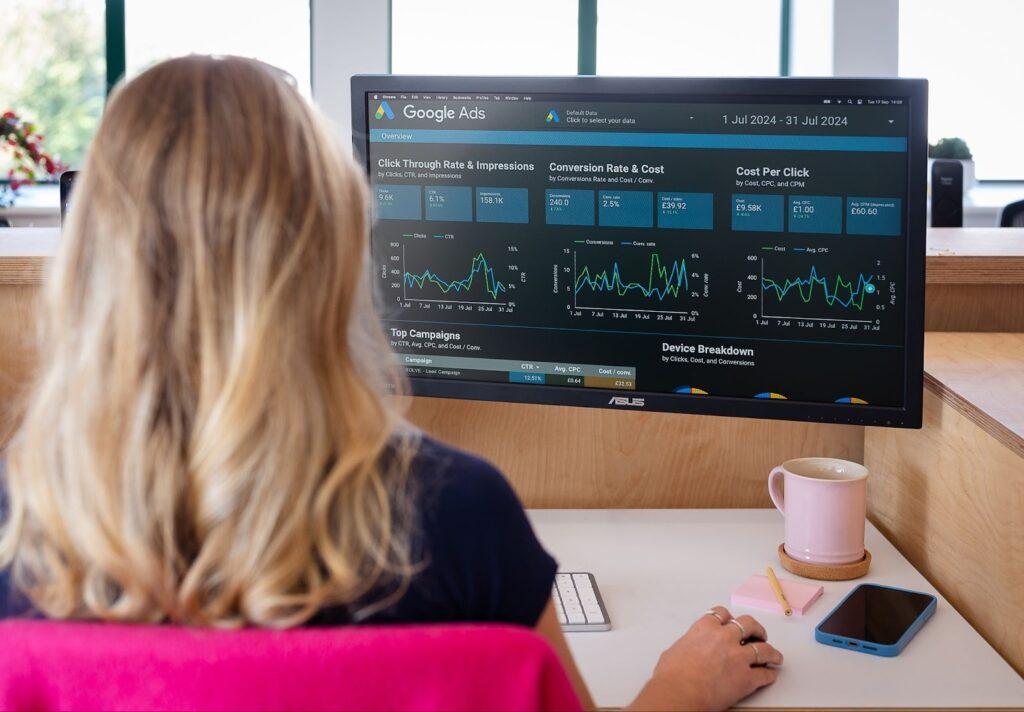
Table of Contents
The Power of PPC
What is PPC
PPC, or pay-per-click advertising, is a digital marketing strategy where you only pay when someone actually clicks on your ad. Instead of investing heavily in broad, unfocused campaigns, PPC allows you to target specific audiences using carefully chosen keywords.
Your ads appear in search results or on relevant websites, putting your brand in front of the right people at the right time, without wasting budget on impressions that don’t convert.
To dive deeper into the meaning of PPC and how it works, check out our blog post ‘PPC Explained’ for a full breakdown.
Why Avoiding PPC Mistakes Saves Budget and Maximises ROI
Running PPC without a clear strategy can quickly drain your budget, especially if you’re targeting the wrong keywords or setting up poorly optimised campaigns. But when executed effectively, PPC delivers impressive ROI and high conversion rates, making every click count.
Common PPC Mistakes to Avoid
1. Poor Keyword Research

It might seem obvious, but one of the most common PPC mistakes is targeting the wrong keywords, which means missing out on valuable clicks and potential customers. Effective keyword research is the foundation of any successful PPC campaign. It determines who sees your ads, how many people you reach, and where your ads appear in search results.
A good keyword will:
- Match user intent (it aligns with what your ideal customer is actively searching for)
- Have a healthy search volume (enough people are searching for it to make it worth targeting)
- Be relevant to your product or service (it connects directly to what you’re offering)
- Fit within your budget (the cost-per-click is reasonable and sustainable)
- Have manageable competition (it’s not so competitive that it drains your budget without conversions)
- Be specific enough to attract qualified traffic (long-tail keywords often bring in users more likely to convert)
- Support your campaign goals (whether it’s awareness, clicks, or conversions, the keyword aligns with your objective)
- Work well in context (it performs effectively when combined with compelling ad copy and a relevant landing page)
2. Ignoring Negative Keywords
Negative keywords are the terms you definitely don’t want your ads to show up for. Think of them as the antithesis of what you want to be found for. For example, if you’re selling luxury watches, you’d likely want to block the keyword “cheap” to avoid showing up in searches like “cheap watches.”
By ignoring negative keywords, you risk wasting ad spend on irrelevant clicks that will never convert. Negative keywords help you filter out traffic that isn’t a good match for your product or service, preventing your ads from showing up in the wrong searches.
3. Weak Ad Copy
Your ad copy is your hook – it’s what grabs attention and earns the click. Weak, generic copy blends into the noise of the search results and gets overlooked. If your message doesn’t stand out or speak directly to your audience’s needs, your ads won’t perform, no matter how good your keywords or targeting are.
4. Poor Audience Targeting
Like any form of marketing, PPC only works if you know exactly who you’re speaking to. If your targeting is too broad or aimed at the wrong people entirely, you’re wasting budget on clicks that will never convert. Effective audience targeting ensures your ads reach the right users, at the right time, with the right message.
Key audience targeting considerations:
- Define your ideal customer (know their demographics, interests, pain points, and behaviours)
- Use audience segments (leverage platform tools to refine your reach)
- Geo-targeting (focus on specific locations where your target audience lives or searches)
- Device targeting (adjust bids or targeting based on whether users are on desktop, mobile, or tablet)
- Time-of-day and day-of-week targeting (show ads when your audience is most active or likely to convert)
- Remarketing (re-engage users who have already interacted with your site or ads)
- Exclude irrelevant audiences (use negative audiences to filter out low-intent or mismatched users)
- Layer targeting options (combine demographics, interests, and behaviours for more precise reach)
5. Ineffective Bidding Strategies
Your bidding strategy directly affects how often and where your ads show up. Whether you’re bidding too aggressively and overspending on low-value clicks, or bidding too conservatively and missing out on high-intent traffic, the result is poor ROI.
An effective bidding strategy should align with your campaign goals, whether that’s driving conversions, maximising clicks, or increasing brand visibility.
6. Neglecting Conversion Tracking

Conversion tracking is one of the most powerful tools in your PPC arsenal. Without it, you’re flying blind, unable to see which ads, keywords, or campaigns are actually driving results. With accurate tracking in place, you can quickly pause underperforming ads, double down on what’s working, and make data-driven decisions that boost ROI.
7. Focusing on Clicks, Not Conversions
Clicks might look good on a report, but they’re meaningless if they don’t lead to action. Driving traffic to your site is only the first step; what really matters is what users do once they get there. If your ads generate plenty of clicks but no conversions, you’re essentially paying for empty visits.
8. Not Using Ad Extensions
Ad extensions are an excellent and often underused tool for enhancing your PPC campaign. They enable you to expand on your message with sitelinks and call buttons, making the likelihood of your viewer clicking on your ad much more promising. You’re providing them with all the information they need upfront, which builds their trust in you and your business.
9. Inadequate Landing Pages
One of the most common mistakes in PPC is neglecting your landing page. You’ve done the hard work, targeted the right audience with smart keywords and captured their attention with compelling ad copy, but if the landing page doesn’t deliver, all that effort goes to waste.
A poor landing page experience, whether due to slow load times, confusing layout, or lack of clear messaging, leads to frustration and fast exits. If users can’t quickly find what they came for, they’ll hit the back button and turn to a competitor. Your landing page should be clean, relevant, mobile-friendly, and laser-focused on guiding the visitor toward conversion.
10. Setting and Forgetting Campaigns
The beauty of online advertising is that it’s flexible. Unlike a billboard, you can tweak and optimise it as you go. But if you simply set up your PPC campaign and walk away, you’re missing a major opportunity to catch performance dips or wasted spend. Great PPC results come from ongoing testing, monitoring, and fine-tuning. Regular optimisations keep your campaigns sharp and your budget working smarter, not harder.
11. Poor Mobile Optimisation

Mobile is no longer optional; it’s essential. With mobile searches surpassing desktop in many industries, your ads and landing pages need to deliver a seamless experience on smaller screens.
In fact, in 2025, 71% of all Google searches now come from mobile devices. If your ads look cluttered, your site loads slowly, or your forms are hard to fill out on mobile, you’re likely losing a chunk of potential conversions. Prioritise mobile-first design to keep users engaged and moving toward action.
PPC Troubleshooting and Best Practices
Regular Account Audits
Go through your PPC account and follow an audit checklist.
During a PPC audit, check the following:
- Keyword performance: Identify underperforming keywords and pause or replace them. Look for high-cost, low-conversion terms
- Search term reports: Spot irrelevant search queries and add them as negative keywords
- Ad performance: Review CTRs, conversion rates, and engagement to see which ads are working and which need revising
- Landing page experience: Ensure pages are relevant, fast-loading, and optimised for both desktop and mobile
- Quality Score: Monitor scores for your keywords and address any factors (like ad relevance or landing page quality) causing low ratings
- Bidding strategies: Make sure your bidding approach still aligns with your campaign goals and performance data
- Budget allocation: Check if your budget is being spent efficiently across campaigns and ad groups
- Ad extensions: Confirm that all relevant extensions are in use and up to date.
- Conversion tracking: Test and confirm that all tracking is functioning correctly and capturing the right actions
Continuous Learning from Competitors
Your competitors can be one of your best sources of insight. Regularly benchmark your ads against theirs to understand what’s working in your industry, and what you can do better. Monitor their messaging, offers, ad formats, and landing pages to spot trends, gaps, and opportunities.
While it’s important to stay aware of the competition, the goal isn’t to copy. Use the information to stay one step ahead and differentiate your brand with stronger value, clearer messaging, or a better user experience.
Start Seeing Success with Solve

Ready to turn clicks into real business growth? Discover how a well-optimised PPC strategy can boost your visibility, leads, and revenue.





